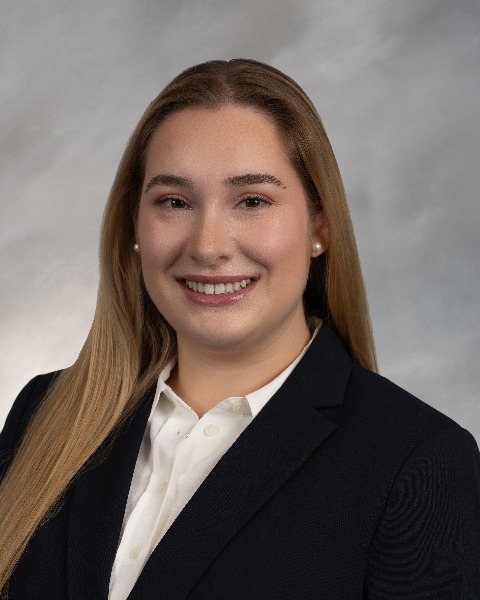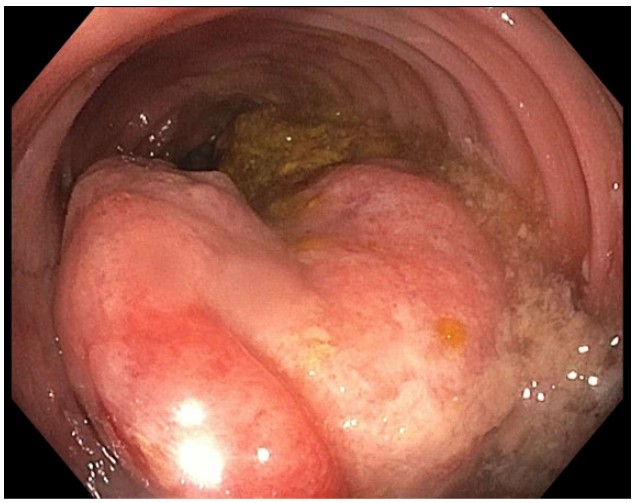Sunday Poster Session
Category: IBD
P1253 - Not Just a Flare: Diffuse Large B-Cell Lymphoma in a Young Patient With Ulcerative Colitis
Sunday, October 26, 2025
3:30 PM - 7:00 PM PDT
Location: Exhibit Hall

Ingrid Rocha, BS (she/her/hers)
Wayne State School of Medicine
Detroit, MI
Presenting Author(s)
Ingrid Rocha, BS1, Suraj Suresh, MD2
1Wayne State School of Medicine, Detroit, MI; 2Henry Ford Health, Detroit, MI
Introduction: Primary colorectal lymphoma (PCL) is a rare malignancy, representing only 0.2–0.6% of all colorectal cancers. Among its histologic subtypes, diffuse large B-cell lymphoma (DLBCL) is the most common. DLBCL of the colon is typically associated with underlying immunosuppression, such as in patients with HIV or those receiving long-term immunosuppressive therapy. Inflammatory bowel disease (IBD), particularly Crohn’s disease, has been linked to an increased risk of lymphoma, especially in patients treated with thiopurines. However, the development of DLBCL in patients with ulcerative colitis (UC), particularly in the absence of immunosuppressive therapy, remains exceedingly rare. This case highlights such an occurrence in a young UC patient and aims to raise awareness of this uncommon but serious complication.
Case Description/
Methods: A 21-year-old male with a one-year history of UC treated solely with balsalazide presented with six months of worsening left-sided abdominal pain and hematochezia. He was hemodynamically stable and afebrile upon presentation, and infectious workup was negative. CT imaging revealed concentric thickening of the proximal sigmoid, descending colon, and splenic flexure, along with a 24×10 cm intramural mass in the descending colon and mildly enlarged pericolonic lymph nodes. Flexible sigmoidoscopy demonstrated severe, continuous inflammation (Mayo Score 3) extending from the rectosigmoid to the proximal descending colon. A large friable partially obstructing mass was visualized at 50 cm from the anal verge (Figure 1). Biopsies confirmed EBV-positive high-grade B-cell lymphoma. The patient began chemotherapy with R-EPOCH but decompensated shortly thereafter, requiring emergency left colectomy with end colostomy due to sigmoid perforation. He completed chemotherapy, and follow-up PET imaging showed complete treatment response with no metabolic evidence of residual disease.
Discussion: This case illustrates an unusual presentation of EBV-associated DLBCL in a young patient with UC and no prior exposure to immunosuppressive agents. Although lymphoma is more frequently linked to Crohn’s disease and immunosuppression, this case underscores the need for vigilance in UC patients presenting with atypical or severe symptoms. A broad diagnostic approach and timely intervention are essential, even in the absence of conventional risk factors, to improve outcomes in such rare but aggressive malignancies.

Figure: Figure 1: Large friable partially obstructing mass in the proximal descending colon
Disclosures:
Ingrid Rocha indicated no relevant financial relationships.
Suraj Suresh indicated no relevant financial relationships.
Ingrid Rocha, BS1, Suraj Suresh, MD2. P1253 - Not Just a Flare: Diffuse Large B-Cell Lymphoma in a Young Patient With Ulcerative Colitis, ACG 2025 Annual Scientific Meeting Abstracts. Phoenix, AZ: American College of Gastroenterology.
1Wayne State School of Medicine, Detroit, MI; 2Henry Ford Health, Detroit, MI
Introduction: Primary colorectal lymphoma (PCL) is a rare malignancy, representing only 0.2–0.6% of all colorectal cancers. Among its histologic subtypes, diffuse large B-cell lymphoma (DLBCL) is the most common. DLBCL of the colon is typically associated with underlying immunosuppression, such as in patients with HIV or those receiving long-term immunosuppressive therapy. Inflammatory bowel disease (IBD), particularly Crohn’s disease, has been linked to an increased risk of lymphoma, especially in patients treated with thiopurines. However, the development of DLBCL in patients with ulcerative colitis (UC), particularly in the absence of immunosuppressive therapy, remains exceedingly rare. This case highlights such an occurrence in a young UC patient and aims to raise awareness of this uncommon but serious complication.
Case Description/
Methods: A 21-year-old male with a one-year history of UC treated solely with balsalazide presented with six months of worsening left-sided abdominal pain and hematochezia. He was hemodynamically stable and afebrile upon presentation, and infectious workup was negative. CT imaging revealed concentric thickening of the proximal sigmoid, descending colon, and splenic flexure, along with a 24×10 cm intramural mass in the descending colon and mildly enlarged pericolonic lymph nodes. Flexible sigmoidoscopy demonstrated severe, continuous inflammation (Mayo Score 3) extending from the rectosigmoid to the proximal descending colon. A large friable partially obstructing mass was visualized at 50 cm from the anal verge (Figure 1). Biopsies confirmed EBV-positive high-grade B-cell lymphoma. The patient began chemotherapy with R-EPOCH but decompensated shortly thereafter, requiring emergency left colectomy with end colostomy due to sigmoid perforation. He completed chemotherapy, and follow-up PET imaging showed complete treatment response with no metabolic evidence of residual disease.
Discussion: This case illustrates an unusual presentation of EBV-associated DLBCL in a young patient with UC and no prior exposure to immunosuppressive agents. Although lymphoma is more frequently linked to Crohn’s disease and immunosuppression, this case underscores the need for vigilance in UC patients presenting with atypical or severe symptoms. A broad diagnostic approach and timely intervention are essential, even in the absence of conventional risk factors, to improve outcomes in such rare but aggressive malignancies.

Figure: Figure 1: Large friable partially obstructing mass in the proximal descending colon
Disclosures:
Ingrid Rocha indicated no relevant financial relationships.
Suraj Suresh indicated no relevant financial relationships.
Ingrid Rocha, BS1, Suraj Suresh, MD2. P1253 - Not Just a Flare: Diffuse Large B-Cell Lymphoma in a Young Patient With Ulcerative Colitis, ACG 2025 Annual Scientific Meeting Abstracts. Phoenix, AZ: American College of Gastroenterology.
